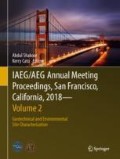Abstract
Rapid urbanization is resulting in increased vertical development and use of anthropogenic materials. Geotechnical site investigation is well established in assessing ground conditions, and moisture specifically is a standard descriptor in soil profile logging and is addressed through a variety of laboratory tests. However, changing moisture conditions, occurring in the vadose zone between land surface and the groundwater table, results in highly variable conditions. Noting the presence and variability in moisture is not sufficient to ensure longevity of engineering structures and protection of water resources. Water at partial saturation is proposed to impact the infrastructure and the vadose zone moisture budget as: (A) perching above lower permeability (lower-k) materials; (B) perching as waterlogged lower-k materials above capillary barriered higher-k materials; both resulting in (C) possible imbibition into less saturated low-k materials; or, under further wetting, resulting in (D) lateral interflow under a hydraulic gradient; (E) gravity-driven percolation breaching capillary barriers and resulting in translatory downward flow; or (F) unsaturated fracture flow. All these mechanisms combine to result in complex moisture implications on infrastructure during project lifecycle, as well as on recharge and contaminant transport rates above the phreatic surface. These are further exacerbated by anthropogenic materials (e.g. made ground) replacing natural materials and infringing on the natural and pre-development subsurface water cycle, as well as climate change, and more elaborate engineering development. Contrary to saturated systems, unsaturated systems result in alternating wetting-drying cycles causing continuous changes in effective stress and redox conditions. The paper addresses some key findings and examples from experiments and case studies.
Access this chapter
Tax calculation will be finalised at checkout
Purchases are for personal use only
References
Attard, G., Winiarski, T., Rossier, Y., Eisenlohr, L.: Review: impact of underground structures on the flow of urban groundwater. Hydrogeol J (2015). https://doi.org/10.1007/s10040-015-1317-3
Brouwers, L.B.: Geotechnical centrifuge modelling of variably saturated flow at the soil-rock interface. MSc Dissertation, (unpub.). University of Pretoria (2017)
Brouwers, L.B., Dippenaar, M.A.: Partially saturated flow from sand into a discrete smooth open vertical fracture at the soil-rock interface: experimental studies. Bull. Eng. Geol. Env. (2018). https://doi.org/10.1007/s10064-018-1258-x
Dippenaar, M.A.: How we lose ground when earth scientists become territorial: defining “soil”. Nat. Resour. Res. 21(1), 137–142 (2012)
Dippenaar, M.A.: Towards hydrological and geochemical understanding of an ephemeral palustrine perched water table “wetland” (Lanseria Gneiss, Midrand, South Africa). Environ. Earth Sci. 72(7), 2447–2456 (2014a)
Dippenaar, M.A.: Towards a multi-faceted Vadose Zone Assessment Protocol: cemetery guidelines and application to a burial site located near a seasonal wetland (Pretoria, South Africa). Bull. Eng. Geol. Environ. 73(4), 1105–1115 (2014b)
Dippenaar, M.A., Van Rooy, J.L.: Review of engineering, hydrogeological and vadose zone hydrological aspects of the Lanseria Gneiss, Goudplaats-Hout River Gneiss and Nelspruit Suite Granite (South Africa). J. Afr. Earth Sc. 91, 12–31 (2014)
Dippenaar, M.A., Van Rooy, J.L.: On the cubic law and variably saturated flow through discrete open rough-walled discontinuities. Int. J. Rock Mech. Min. Sci. 89, 200–211 (2016)
Ehlen, J.: Above the weathering front: contrasting approaches to the study and classification of weathered mantle. Geomorphology 67, 7–21 (2005)
Jones, B.R., Brouwers, L.B., Dippenaar, M.A.: Partially to fully saturated flow through smooth, clean, open fractures: qualitative experimental studies. Hydrogeol. J. (2017a). https://doi.org/10.1007/s10040-017-1680-3
Jones, B.R., Brouwers, L.B., van Tonder, W.D., Dippenaar, M.A.: Assessing geotechnical centrifuge modelling in addressing variably saturated flow in soil and fractured rock. Environ. Sci. Pollut. Res. 24, 13203–13223 (2017b)
Lerner, D.N.: Identifying and quantifying urban recharge: a review. Hydrogeol. J. 10, 143–152 (2002)
Van Allemann, S.T.,: A laboratory simulation of the potential groundwater contamination associated with Burial Materials. MSc dissertation (unpub.), University of Pretoria (2017)
Van Allemann, S.T., Oliver, J., Dippenaar, M.A.: A laboratory simulation of the pollution of formaldehyde in cemeteries (South Africa). Environ. Earth Sci. (2018). https://doi.org/10.1007/s12665-017-7219-z
Vásquez-Suñé, E., Sánchez-Vila, X., Carrera, J.: Introductory review of specific factors influencing urban groundwater, an emerging branch of hydrogeology, with reference to Barcelona, Spain. Hydrogeol J. 13, 522–533 (2005)
Author information
Authors and Affiliations
Corresponding author
Editor information
Editors and Affiliations
Rights and permissions
Copyright information
© 2019 Springer Nature Switzerland AG
About this paper
Cite this paper
Dippenaar, M.A., van Rooy, J.L. (2019). Vadose Zone Characterisation for Hydrogeological and Geotechnical Applications. In: Shakoor, A., Cato, K. (eds) IAEG/AEG Annual Meeting Proceedings, San Francisco, California, 2018 - Volume 2. Springer, Cham. https://doi.org/10.1007/978-3-319-93127-2_10
Download citation
DOI: https://doi.org/10.1007/978-3-319-93127-2_10
Published:
Publisher Name: Springer, Cham
Print ISBN: 978-3-319-93126-5
Online ISBN: 978-3-319-93127-2
eBook Packages: Earth and Environmental ScienceEarth and Environmental Science (R0)

